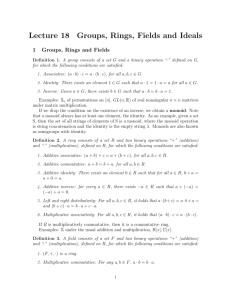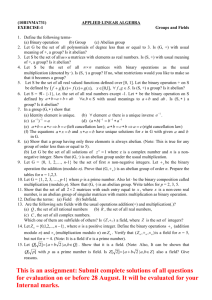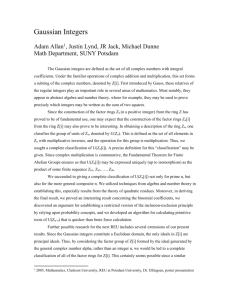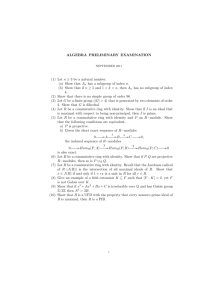Algebra fact sheet An algebraic structure (such as group, ring, field
advertisement
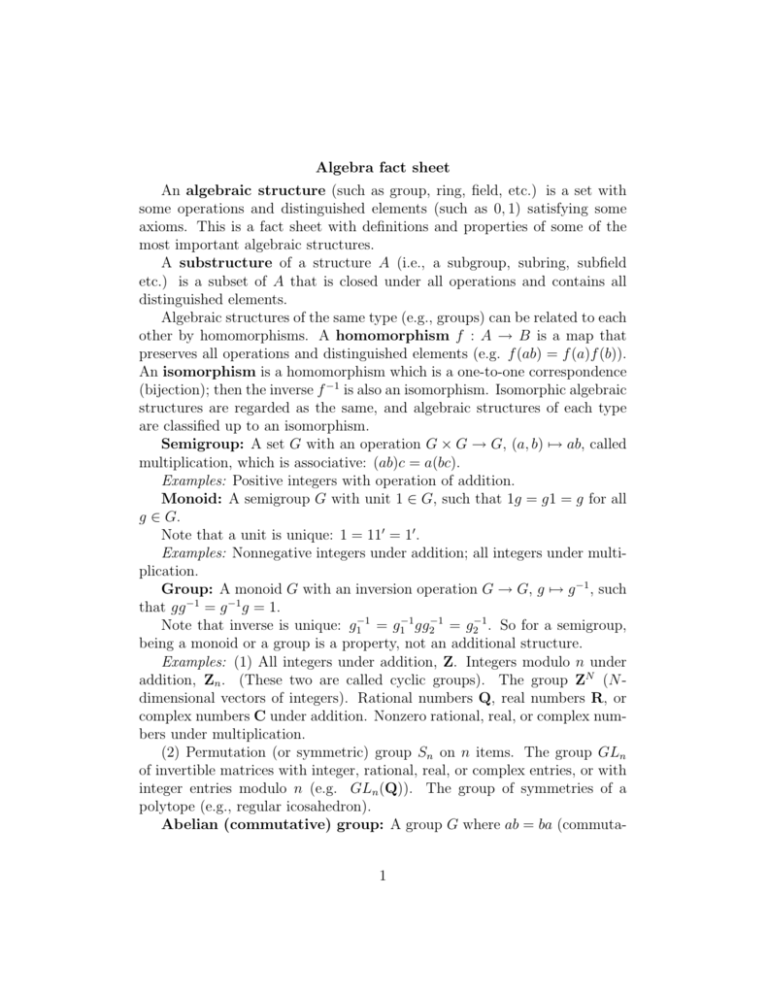
Algebra fact sheet
An algebraic structure (such as group, ring, field, etc.) is a set with
some operations and distinguished elements (such as 0, 1) satisfying some
axioms. This is a fact sheet with definitions and properties of some of the
most important algebraic structures.
A substructure of a structure A (i.e., a subgroup, subring, subfield
etc.) is a subset of A that is closed under all operations and contains all
distinguished elements.
Algebraic structures of the same type (e.g., groups) can be related to each
other by homomorphisms. A homomorphism f : A → B is a map that
preserves all operations and distinguished elements (e.g. f (ab) = f (a)f (b)).
An isomorphism is a homomorphism which is a one-to-one correspondence
(bijection); then the inverse f −1 is also an isomorphism. Isomorphic algebraic
structures are regarded as the same, and algebraic structures of each type
are classified up to an isomorphism.
Semigroup: A set G with an operation G × G → G, (a, b) 7→ ab, called
multiplication, which is associative: (ab)c = a(bc).
Examples: Positive integers with operation of addition.
Monoid: A semigroup G with unit 1 ∈ G, such that 1g = g1 = g for all
g ∈ G.
Note that a unit is unique: 1 = 110 = 10 .
Examples: Nonnegative integers under addition; all integers under multiplication.
Group: A monoid G with an inversion operation G → G, g 7→ g −1 , such
that gg −1 = g −1 g = 1.
Note that inverse is unique: g1−1 = g1−1 gg2−1 = g2−1 . So for a semigroup,
being a monoid or a group is a property, not an additional structure.
Examples: (1) All integers under addition, Z. Integers modulo n under
addition, Zn . (These two are called cyclic groups). The group ZN (N dimensional vectors of integers). Rational numbers Q, real numbers R, or
complex numbers C under addition. Nonzero rational, real, or complex numbers under multiplication.
(2) Permutation (or symmetric) group Sn on n items. The group GLn
of invertible matrices with integer, rational, real, or complex entries, or with
integer entries modulo n (e.g. GLn (Q)). The group of symmetries of a
polytope (e.g., regular icosahedron).
Abelian (commutative) group: A group G where ab = ba (commuta-
1
tivity).
Examples: The examples from list (1) above.
If A is an abelian group, one often denotes the operation by + and 1 by
0.
Action of a monoid or a group on a set: A left action of a monoid
(in particular, a group) G on a set X is a multiplication map G × X → X,
(g, x) 7→ gx such that (gh)x = g(hx) and 1x = x. Similarly one defines a
right action, (x, g) 7→ xg.
Examples. Any monoid (in particular, group) acts on itself by left and
right multiplication. The symmetric group Sn acts on {1, ..., n}. Matrices
act on vectors. The group of symmetries of a regular icosahedron acts on the
sets of its points, vertices, edges, faces and on the ambient space.
Normal subgroup: A subgroup H ⊂ G such that gH = Hg for all
g ∈ G.
Quotient group: If A is an abelian group and B a subgroup in A, then
A/B is the set of subsets aB in A (where a ∈ A) with operation a1 Ba2 B =
a1 a2 B; this defines a group structure on A/B. If A is not abelian, then in
general A/B is just a set with a left action of A. For it to be a group (i.e.,
for the formula a1 Ba2 B = a1 a2 B to make sense), B needs to be a normal
subgroup. This is automatic for abelian groups A.
Examples. Z/nZ = Zn . S3 /Z3 = Z2 .
Lagrange’s theorem: The order (i.e., number of elements) of a subgroup H of a finite group G divides the order of G (the quotient |G|/|H| is
|G/H|).
The order of g ∈ G is the smallest positive integer n such that g n = 1
(∞ if there is none). Equivalently, the order of g is the order of the subgroup
generated by g. Thus by Lagrange’s theorem, the order of g divides the order
of G. This implies that any group of order p (a prime) is Zp .
Direct (or Cartesian) product (of semigroups, monoids, groups):
G×H is the set of pairs (g, h), g ∈ G, h ∈ H, with componentwise operation.
One can also define a direct product of more than two factors. For abelian
groups, the direct product is also called the direct sum and denoted by ⊕.
Generators: A group G is generated by a subset S ⊂ G if any element
of G is a product of elements of S and their inverses. A group is finitely
generated if it is generated by a finite subset.
Classification theorem of finitely generated abelian groups. Any
finitely generated abelian group is a direct sum of infinite cyclic groups (Z)
2
and cyclic groups of prime power order. Moreover, this decomposition is
unique up to order of factors (and up to isomorphism).
(Unital) ring: An abelian group A with operation + which also has
another operation of multiplication, (a, b) 7→ ab, under which A is a monoid,
and which is distributive: a(b + c) = ab + ac, (b + c)a = ba + ca.
Examples: (1) The integers Z. Rational, real, or complex numbers. Integers modulo n (Zn ). Polynomials Q[x], Q[x, y].
(2) Matrices n by n with rational, real, or complex entries, e.g. Matn (Q).
Commutative ring: A ring in which ab = ba.
Examples: List (1) of examples of rings.
Division ring: A ring in which all nonzero elements are invertible (i.e.,
form a group).
Examples: Rational, real, complex numbers. Integers modulo a prime
(Zp ). Quaternions.
Field: A commutative division ring.
Examples: Rational, real, complex numbers. Integers modulo a prime
(Zp ).
Characteristic of a field F : The smallest positive integer p such that
1 + ... + 1 (p times) is zero in F . If there is no such p, the characteristic is
said to be zero. If the characteristic is not zero then it is a prime.
Examples: The characteristic of Zp is p. The characteristic of Q is zero.
Algebra over a field F : A ring A containing F such that elements of
F commute with all elements of A.
Examples: Q[x], Q[x, y], Mat2 (Q) (2 by 2 matrices with rational enties)
are algebras over Q.
(Left) module over a ring A: An abelian group A with a multiplication
A × M → M , (a, m) 7→ am which is associative ((ab)m = a(bm)) and
distributive (a(m1 + n2 ) = am1 + am2 , (a1 + a2 )m = a1 m + a2 m), and such
that 1m = m (i.e., the monoid A acts on M , and the action is distributive in
both arguments). Similarly one defines right modules (with multiplication
(m, a) 7→ ma). Note that for a commutative ring, a left module is the same
thing as a right module.
Examples: A module over Z is the same thing as an abelian group. Also,
for any ring A, An = A ⊕ ... ⊕ A (n times) is a module over A, left and
right (called free module of rank n). More generally, if S is a set,P
then the
free A-module A[S] with basis S is the set of formal finite sums s∈S as s,
as ∈ A, where all as but finitely many are zero.
3
Quotient module: If N ⊂ M are A-modules, then so is the quotient
M/N .
Vector space: A module over a field.
Examples: F n , where F is a field. The space of complex-valued functions
on any set X.
Basis of a vector space V : A collection of elements
P{vi } such that any
element (vector) v ∈ V can be uniquely written as v =
ai vi , ai ∈ F .
Basis theorem: A basis always exists and all bases have the same number of elements (which could be infinite). This number is called the dimension
of V .
Theorem: Any finite field has order pn , where p is its characteristic
(which is a prime).
Indeed, such a field is a vector space over Zp of some finite dimension n,
so its order is pn .
In fact, for any prime power q there is a unique finite field of order q,
denoted Fq .
Linear map: A homomorphism of vector spaces, i.e. a map f : V → W
of vector spaces over a field F such that f (a + b) = f (a) + f (b), and f (λa) =
λf (a) for λ ∈ F .
Examples: A matrix n by m over F defines a linear map F m → F n . The
derivative d/dx is a linear map from C[x] to itself.
Ideal: A left ideal in a ring A is a left submodule of A, i.e., a subgroup
I ⊂ A such that AI = I. Similarly, a right ideal is a right submodule of A
(IA = A). A two-sided ideal is a left ideal which is also a right ideal.
Examples: f ∈ A, I = Af is the ideal of all multiples of f . For example,
nZ inside Z.
If I ⊂ A is a left ideal, then the quotient group A/I is a left A-module.
If I is a two-sided ideal, then A/I is a ring.
Examples: Z/nZ = Zn . R[x]/(x2 + 1) = C.
Lie algebra: A vector space L over a field F with a bracket operation
[, ] : L×L → L, which is bilinear (i.e., [a, b] is linear with respect to a for fixed
b and with respect to b for fixed a), skew-symmetric ([a, a] = 0, so [a, b] =
−[b, a]), and satisfies the Jacobi identity [a, [b, c]] + [b, [c, a]] + [c, [a, b]] = 0.
Examples: Any algebra A with [a, b] = ab − ba is a Lie algebra. So square
matrices over a field form a Lie algebra. Other examples are the Lie algebra
of matrices with trace zero and the Lie algebra of skew-symmetric matrices
(X T = −X).
4
Tensor product of modules: If A is a ring, M is a right A-module, and
N a left A-module, then M ⊗A N is the quotient of the free abelian group
with basis S = {m ⊗ n, m ∈ M, n ∈ N } (where m ⊗ n are formal symbols)
by the subgroup spanned by
(m1 +m2 )⊗n−m1 ⊗n−m2 ⊗n, m⊗(n1 +n2 )−m⊗n1 −m⊗n2 , ma⊗n−m⊗an,
where a ∈ A. By doing this we force the relations saying that the expressions
above are zero.
Note that if A is commutative then left and right module is the same
thing, and so M, N are just A-modules. Moreover, in this case the abelian
group M ⊗A N is also an A-module: a · (m ⊗ n) = ma ⊗ n = m ⊗ an.
Example: Zr ⊗Z Zs = Zgcd(r,s) . For example, Z2 ⊗Z Z3 = 0.
Theorem: If V, W are vector spaces over a field F with bases vi and wj
then the set of elements vi ⊗ wj is a basis of V ⊗F W . In particular, the
dimension of V ⊗F W is the product of dimensions of V and W .
So, unlike abelian groups, the tensor product of nonzero vector spaces is
nonzero.
5

